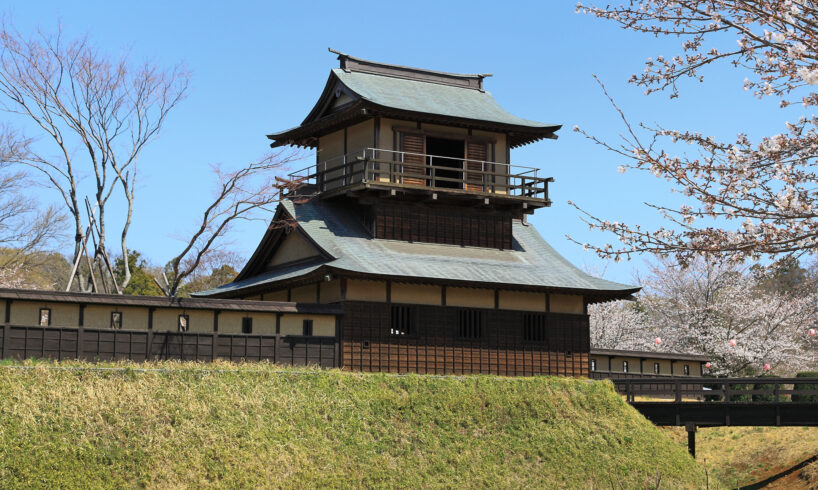
Located in Bando city, Ibaraki Prefecture, Sakasai Castle is … a fine old fortress. Though technically, it’s not that old since most of it — from the moats to the bridges, turrets and the main gate — is a reconstruction from the 1990s. The expansive Sakasai Castle Park surrounding the rebuilt structure is today a popular cherry blossom-viewing spot, but it’s a bit inconvenient to get to without a car, so you might think, why bother? Because, underneath its unassuming facade, Sakasai Castle is brimming with tales of death, despair, ninjas and a lost aquatic kingdom.
Example of a bronze Japanese bell, Azuchi Castle Sogenji Temple
The Tragic Story of the Sakasai Diving Bell
The original castle belonged to the Sakasai clan (no surprise there) from 1456 to 1536, until it was taken over by the Later Hojo. But “taken over” is the mother of all euphemisms here, obscuring a dark and bloody truth. In the 16th century, the Later Hojo were aiming to take control of eastern Japan (Kanto) and Sakasai Castle was one of the keys to their expansion. It was a strategic fortification for securing the northern parts of Kanto, so when the Hojo came for it, they came for it hard.
The Hojo assault was brutal, resulting in the death of the castle’s lord, Sakasai Tsuneshige, and most of his warriors. His female family members had it worse, though, because they knew that before being killed, they would most likely be violated. Even if they lived, they’d basically live like slaves, and one of them didn’t accept that.
Deciding to go out on her own terms, Tomohime or Tomogozen, the daughter of Tsuneshige (sometimes identified as his wife), took her naginata glaive — a common weapon for female warriors of all ages — and cut down the castle’s large bronze bell. Slipping inside it and wearing it like armor, she proceeded to walk into the castle pond, where she drowned herself.
The body of water later became known as Kanebori-ike, or “Bell Digging Pond,” since locals apparently tried repeatedly to retrieve the bell and Tomohime/Tomogozen’s remains from it. They found neither, which only fueled her legend. Today, in parts of Ibaraki Prefecture, she is still remembered as a symbol of bravery, sacrifice and honor, while also reminding people of the grim fate of women during sieges.
Depiction of the Fuma Clan with leader Fuma Kataro (right) by Eiji Ikeda | National Diet Collections, Wikimedia
Home of the Wind Demons
Legend goes that one of the secrets to the Later Hojo’s power was a loyal clan of ninjas called the Fuma, literally meaning “Wind Demons.” There are enough historical accounts and documents to prove that they existed. But rather than assassins clad in black who eliminated enemies with shuriken to the throat, they were a highly trained guerrilla unit used for asymmetrical and psychological warfare.
They REALLY excelled at the last one. The Fuma claimed descent from Taira no Masakado, a god of wrath whose decapitated head makes up the foundation of modern Tokyo. They disguised themselves as yokai monsters and made use of pyrotechnics to scare their enemies. Even their name was possibly a kind of weapon, since it might have originally been written with the characters for “Wind” and “Space,” which the clan later changed to “Wind Demons” for branding purposes.
So, once the Later Hojo took over Sakasai Castle, they started using it as a base for several hundred Fuma ninja, who were dispatched all over the area to further the clan’s conquest of Kanto. Their typical roles in battle included night ambushes meant to lower morale, sabotage, theft of horses and even going into enemy camps in disguise to spread damaging misinformation, like they allegedly did during the Siege of Odawara against Toyotomi Hideyoshi, the second great unifier of Japan. It wasn’t enough, though, and the Later Hojo were wiped out by Toyotomi, after which the Fuma turned to banditry until their leader was ultimately captured and executed by the shogunate.
A Landlocked Venice of Japan
The Fuma were also known for their great boating skills, which you wouldn’t think would be relevant while stationed at a castle roughly 80 kilometers from the ocean. But Sakasai is a flatland fortress surrounded by the Nishinire River, moats, canals and, before they were reclaimed, 30 kilometers of marshes, which all connected to create a VAST waterway system that both the Sakasai and Later Hojo used extensively.
During the reconstruction of the castle, based on original plans, it was discovered that the moat once had boat landings, a rarity in Japanese fortifications located so deep inland. Archaeological excavations found the remains of these wharfs, as well as shallow harbor zones, suggesting that the occupants of Sakasai Castle made frequent use of boats, most likely to transport troops, supplies and, yes, ninjas. Boat ninjas! Someone needs to make that anime.
It’s believed that the system of moats, canals, marshes, rivers and lakes was how the Fuma primarily moved through the area during the Later Hojo’s conquest years. It also would have been helpful in stealthily transporting them behind enemy lines in case someone came knocking on Sakasai Castle’s gates. However, during their initial years, the waterways were primarily used for communication and the exchange of emissaries between different clans, creating a now sadly forgotten mini water empire in this corner of Japan.
Related Posts
Discover Tokyo, Every Week
Get the city’s best stories, under-the-radar spots and exclusive invites delivered straight to your inbox.





